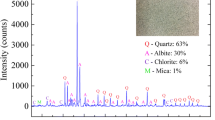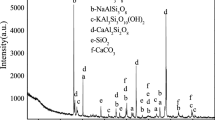Abstract
A detailed understanding of damage evolution in rock after high-temperature treatment in unloading conditions is extremely important in underground engineering applications, such as the disposal of highly radioactive nuclear waste, underground coal gasification, and post-disaster reconstruction. We have studied the effects of temperature (200, 400, 600 and 800 °C) and confining pressure (20, 30 and 40 MPa) on the mechanical properties of sandstone. Scanning electron microscopy studies revealed that at temperatures exceeding 400 °C, new cracks formed, and original cracks extended substantially. When the confining pressure was 20 MPa, a temperature increase from 400 to 800 °C resulted in a 75.2% increase in peak strain, a decrease in Young’s modulus and peak strength of 62.5 and 35.8 %, respectively, and transition of the failure mechanism from brittleness to ductility. In the triaxial compression tests, the specimen deformed in a more obvious ductile failure manner at higher confining pressure, whereas in the unloading confining pressure experiments, brittle failure was more obvious when the initial confining pressure was higher. We focused on the effects of temperature and initial confining pressure on peak effective loading stress and peak ductile deformation during unloading. At temperatures of >400 °C, the peak ductile deformation increased rapidly with increases in the high temperature treatment or initial confining pressure. The peak effective loading stress decreased sharply with increased temperature but barely changed when the initial confining pressure was varied.









Similar content being viewed by others
References
Brotóns V, Tomás R, Ivorra S, Alarcón JC (2013) Temperature influence on the physical and mechanical properties of a porous rock: San Julian’s calcarenite. Eng Geol 167:117–127
Burton E, Friedmann J, Upadhye R (2006) Best practices in underground coal gasification, draft. US DOE Contract No W-7405-Eng-48. Lawrence Livermore National Laboratory, Livermore
Chaki S, Takarli M, Agbodjan WP (2008) Influence of thermal damage on physical properties of a granite rock: porosity, permeability and ultrasonic wave evolutions. Constr Build Mater 22(7):1456–1461
Chopra PN (1997) High-temperature transient creep in olivine rocks. Tectonophysics 279(1–4):93–111
Couch GR (2009) Underground coal gasification. IEA Clean Coal Center, International Energy Agency, London. ISBN 978-92-9029-471-9
Darot M, Reuschlé T (2000) Acoustic wave velocity and permeability evolution during pressure cycles on a thermally cracked granite. Int J Rock Mech Min 37(7):1019–1026
De Bresser JHP, Urai JL, Olgaard DL (2005) Effect of water on the strength and microstructure of Carrara marble axially compressed at high temperature. J Struct Geol 27(2):265–281
Fairhurst CE, Hudson JA (1999) Draft ISRM suggested method for the complete stress–strain curve for the intact rock in uniaxial compression. Int J Rock Mech Min 36(3):279–289
Ferrero AM, Marini P (2001) Experimental studies on the mechanical behaviour of two thermal cracked marbles. Rock Mech Rock Eng 34(1):57–66
Garitte B, Gens A, Vaunat J, Armand G (2014) Thermal conductivity of argillaceous rocks: determination methodology using in situ heating tests. Rock Mech Rock Eng 47(1):111–129
Géraud Y, Mazerolle F, Raynaud S (1992) Comparison between connected and overall porosity of thermally stressed granites. J Struct Geol 14(8–9):981–990
Glover PWJ, Baud P, Darot M et al. (1995) Phase transition in quartz monitored using acoustic emissions. Geophys J Int 120:775–782
He MC, Miao JL, Feng JL (2010) Rock burst process of limestone and its acoustic emission characteristics under true-triaxial unloading conditions. Int J Rock Mech Min 47(2):286–298
Heuze FE (1983) High-temperature mechanical, physical and thermal properties of granitic rocks—a review. Int J Rock Mech Min Sci Geomech Abstr 20(1):3–10
Hua AZ, You MQ (2001) Rock failure due to energy release during unloading and application to underground rock burst control. Tunn Undergr Space Technol 16(3):241–246
Liang WG, Xu SG, Zhao YS (2006) Experimental study of temperature effects on physical and mechanical characteristics of salt rock. Rock Mech Rock Eng 39(5):469–482
Liu EL (2012) Deformation mechanisms of crushable blocky materials upon lateral unloading for a biaxial stress state. Rock Mech Rock Eng 45(3):439–444
Luo J, Wang LG (2011) High-temperature mechanical properties of mudstone in the process of underground coal gasification. Rock Mech Rock Eng 44(6):749–754
Najafi M, Jalali SME, KhaloKakaie R (2014) Thermal-mechanical-numerical analysis of stress distribution in the vicinity of underground coal gasification (UCG) panels. Int J Coal Geol 134:1–16
Ozguven A, Ozcelik Y (2014) Effects of high temperature on physico-mechanical properties of Turkish natural building stones. Eng Geol 183:127–136
Qiu SL, Feng XT, Xiao JQ, Zhang CQ (2014) An experimental study on the pre-peak unloading damage evolution of marble. Rock Mech Rock Eng 47(2):401–419
Schanz T, Long N-T, Datcheva M (2013) A column experiment to study the thermo-hydro-mechanical behaviour of expansive soils. Rock Mech Rock Eng 46(6):1287–1301
Sengun N (2014) Influence of thermal damage on the physical and mechanical properties of carbonate rocks. Arab J Geosci 7(12):5543–5551
Shao SS, Wasantha PLP, Ranjith PG, Chen BK (2014) Effect of cooling rate on the mechanical behavior of heated Strathbogie granite with different grain sizes. Int J Rock Mech Min 70:381–387
Shao SS, Ranjith PG, Wasantha PLP, Chen BK (2015) Experimental and numerical studies on the mechanical behaviour of Australian Strathbogie granite at high temperatures: an application to geothermal energy. Geothermics 54:96–108
Sun Q, Zhang ZZ, Xue L, Zhu S (2013) Physico–mechanical properties variation of rock with phase transformation under high temperature. Chin J Rock Mech Eng 32(5):2034–2041
Xie HQ, He C (2004) Study of the unloading characteristics of a rock mass using the triaxial test and damage mechanics. Int J Rock Mech Min 41(3):366
Xu XL, Gao F, Zhang ZZ (2014) The influence of confining pressure on deformation and strength properties of granite after high temperatures. Chin J Geot Eng 36(12):2246–2252
Yang SQ, Jing HW, Wang SY (2012) Experimental investigation on the strength, deformability, failure behavior and acoustic emission locations of red sandstone under triaxial compression. Rock Mech Rock Eng 45(4):583–606
Yavuz H, Demirdag S, Caran S (2010) Thermal effect on the physical properties of carbonate rocks. Int J Rock Mech Min 47(1):94–103
You MQ (2000) Strength and deformation failure process of rock specimens. Geology Press, Beijing
Zhang LY, Mao XB, Liu RX, Guo XQ, Ma D (2014) The mechanical properties of mudstone at high temperatures: an experimental study. Rock Mech Rock Eng 47(4):1479–1484
Zhang ZX, Yu J, Kou SQ, Lindqvist PA (2001) Effects of high temperatures on dynamic rock fracture. Int J Rock Mech Min 38(2):211–225
Zhao Y, Wan Z, Feng Z, Yang D, Zhang Y, Qu F (2012) Triaxial compression system for rock testing under high temperature and high pressure. Int J Rock Mech Min 52:132–138
Acknowledgments
This work was supported by the National Basic Research Program of China (Grant No. 2013CB227900) and the National Natural Science Foundation of China (Grant No. 51304206 and No. U1261201). The authors also thank the editor, two anonymous reviewers, and Dr. W. M. Yang for their valuable suggestions, which have greatly improved this paper.
Author information
Authors and Affiliations
Corresponding author
Rights and permissions
About this article
Cite this article
Ding, QL., Ju, F., Mao, XB. et al. Experimental Investigation of the Mechanical Behavior in Unloading Conditions of Sandstone After High-Temperature Treatment. Rock Mech Rock Eng 49, 2641–2653 (2016). https://doi.org/10.1007/s00603-016-0944-x
Received:
Accepted:
Published:
Issue Date:
DOI: https://doi.org/10.1007/s00603-016-0944-x




